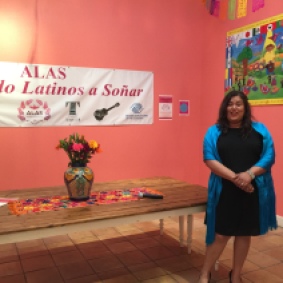Telling a story about an ancestor can be a gift to oneself and to one’s family. It is powerful to have your stories heard. It is a great community building experience too, because it allows others to think about their own ancestors and stories.
Here is how Lisa Petrides and I created “Grandmothers from far lands” together.
Capturing the memories
We did a meditation to ask our grandmothers what they wanted conveyed in our storytelling. Then we both took some individual time to write down some of the things we remembered about our grandmothers. We thought about their history, things we liked about them, some hardships, our relationship with these women.
Collaborating – the similarities and contrasts
We got together and shared these stories and discovered that there were similar veins, for example, both our grandmothers had arranged marriages. It was through these marriages that they came to America. We also began to notice how different their lives were in America. Lisa’s grandmother lived in a city and my grandmother lived in a houseboat. Culturally their temperaments and styles were also a contrast we worked with.

Following the flow
We used the time line as the flow of the story. We started in their native countries and traveled over the ocean to America. We walked, following the shape of an infinity sign, to tell about the long ship journey. We brought in props which anchored their stories and clued viewers into where they were and what they were doing. As we took turns speaking, the other person swept the floor behind them. Lisa spoke in her grandmother’s voice as she washed dishes, and I was my grandmother as she washed the rice.
Practicing in the space
If at all possible practice in the space you will be performing in. This allows you to be more familiar with the sound level, lighting, seating, etc. If that isn’t possible, envision the space as you practice elsewhere.
Invite critiques
Before two shows we invited some folks in to critique our performance. We got some great feedback about background music and adding movement. We were able to make some changes which improved the show.

Promote
We did some advertising and promotion through the local newspapers, email, postcards, and posters. After doing all that preparation, it is nice to have an audience! Of course that all took some advance planning since the pr had to be out almost a month ahead of time.
Performing it
On the day of the performance try to take it easy so you will be at your best. We passed out brief programs so the audience could have something to read and follow what we were doing. We did a little introduction and then went into the 15 minute performance. At the end we invited the audience to participate by standing and speaking their own grandmother’s name and many did so.
Allow for transformation
Lisa and I have changed the performance each time we have done it. Sometimes it depended on the venue. We have told our grandmothers’ stories in an art gallery, a senior center, and at a yoga center. It is important to keep in mind who you are telling the story to. For example if I were to do it for seniors again, I would invite them to have a sharing session afterwards so they could share their own tales.
Sometimes the stories change themselves, revealing more memories to incorporate in the performance. Sometimes we change in the way we want to speak. Allow for fun, change, and mystery that evolves with memories and storytelling.
Suggested educational uses
Provide your students with a list of questions and possible ancestor they can research. Have them bring in photographs and stories they have gathered. The students will break into groups based on which ancestors they selected. They will meet and discuss similarities and contrasts. Have them write up a 15 minute script and practice their performance. Document their presentations using video and photography.
There are many overlapping tie-ins:
- history
- theater
- social studies
- language
- culture
- arts











